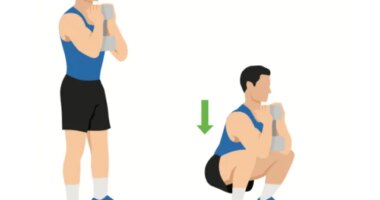The product recommendations in this post are recommendations by the writer and/or expert(s) interviewed and do not contain affiliate links. Meaning: If you use these links to buy something, we will not earn a commission.
Today, countless Americans will set out in search of hydration. You’re probably one of them. And you likely have a good reason.
Maybe you’re starting a new fitness routine. Getting more exercise is a popular New Year’s resolution, whether you stick with it or not. Maybe you’re recovering from illness. There are so many nasty viruses going around right now. Or, maybe you’re just feeling downright awful after a raucous New Year’s Eve on the town.
Either way, you probably want a sports drink; Gatorade being the most popular brand. Oh, but which kind? It’s not a simple choice of red, yellow or orange. Not anymore.
Nowadays, there are multiple varieties staring back at you from the refrigerator case. Each offers a steady supply of essential electrolytes, but different levels and styles of sweetener.
Don’t just stand there scratching your aching head. Make an informed decision.
For guidance, we reached out to hydration expert and registered dietitian Amy Goodson, MS, RD, CSSD, LD, author of The Sports Nutrition Playbook and member of our Expert Medical Board. Full disclosure: Goodson sometimes consults for Gatorade and the company pays her to speak about sports nutrition. That said, she knows these products about as well as anyone. She’s also the first to admit that not every type of Gatorade is good for everyone or every type of activity. In fact, she says, some people shouldn’t drink sports drinks at all.
Sports drinks, by definition, are just that: drinks for people playing sports. They’re made to replenish the things you lose during exercise: basically, sugar, salt and fluid. “If you are running and sweating, sugar, salt and fluid are your friends,” Goodson says. “If you are sitting around doing nothing, then they’re not.”
READ RELATED: How to sleep: Drink this with your evening meal to improve sleep quality
Even so, you don’t have to be an elite athlete to benefit from one of these beverages. You just need to pick the right one for you and your lifestyle. Herewith, the full breakdown of your best and worst options in the capital G-labeled bottle:
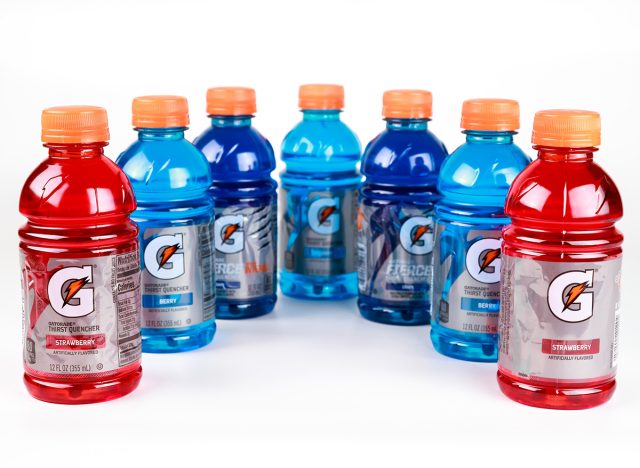

The big knock on the OG (fruit punch, lemon lime, orange and over a dozen other assorted flavors) is the sugar content: 34 grams in a 20-ounce bottle. Of course, the sugar is sort of the whole point. If you are doing intense exercise, you’re burning carbs like sugar. If you don’t consume more, eventually you’re going to run out of energy. The OG Thirst Quencher is specifically designed to address this. “It’s enough carbohydrates to give you some energy but it gets out of your gut quickly so it can get into the bloodstream and the muscles can uptake it for energy,” Goodson explains. If you are playing competitive sports for hours on end (at least 90 minutes or more), or training for a marathon, the OG is the right sports drink for you. If not, move on. “That was designed for an athlete–end of story,” Goodson says. “It wasn’t designed for someone who got drunk last night.”
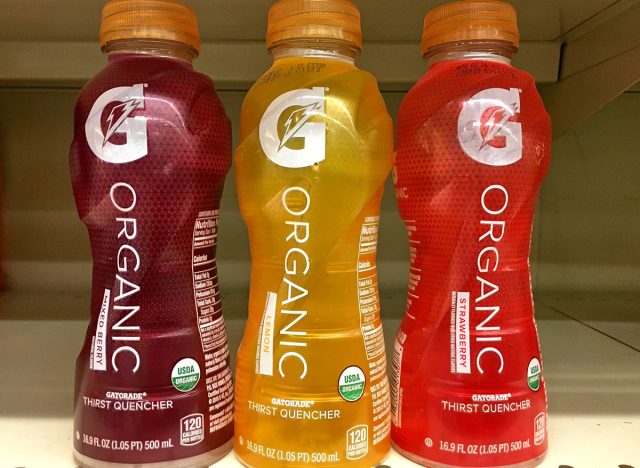

Launched in 2016, Gatorade Organic offers essentially the same level of carbohydrates and electrolytes as the OG. The difference is the flavoring: organic sugar and sea salt versus regular sugar and salt. The organic version arrived in response to rising consumer demand for more natural products. If you’re the kind of highly active person who also swears by the USDA Organic label, then this is the sports drink for you. Otherwise, keep shopping. “I like to remind people that organic does not make something better or worse for you, from a health perspective,” Goodson says. “It’s simply how the products were grown or made.”


The newest arrival to Gatorade’s ever-colorful lineup, which dropped just last year, one-ups the organic variety by virtually eliminating sugar entirely: Just one gram, in fact, which comes from concentrated watermelon juice, and a mere three total carbs. It also contains the natural sweetener stevia, which is not to everyone’s taste. Created for “nutritionally discerning athletes,” according to the company, the drink comes loaded with added vitamins (A, C, B6) and all the usual electrolytes. Same sodium levels as the OG, so if you don’t get much exercise, it’s best to avoid, Goodson warns.
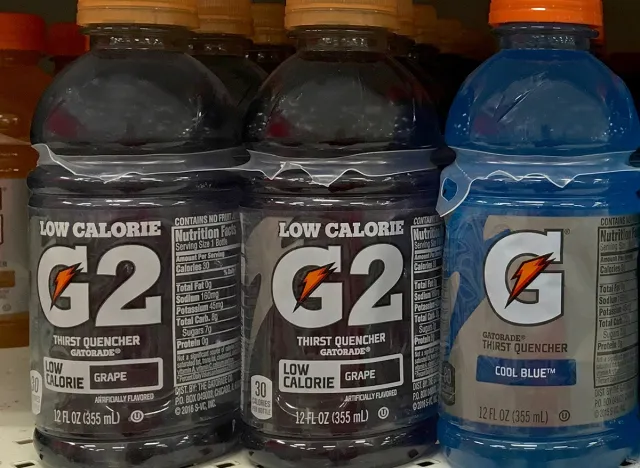

Gatorade’s first departure from its original formula, G2 hit the market in 2007 amid souring public sentiment toward sugary drinks. It contains about half as much sugar as the OG. The rest of the flavor comes from the low-calorie artificial sweetener Sucralose (aka Splenda). That’s not necessarily a bad thing, according to Goodson. “Some people are very passionate one way or the other,” she says of the natural versus artificial debate. “Artificial sweeteners are approved by the FDA to be safe. I always tell people it’s a personal preference.” G2 is essentially made for active people to hydrate during less-active times, like after an intense practice when you’re still thirsty but not burning energy. “They don’t need the sugar content because they’re not moving as much,” she says.
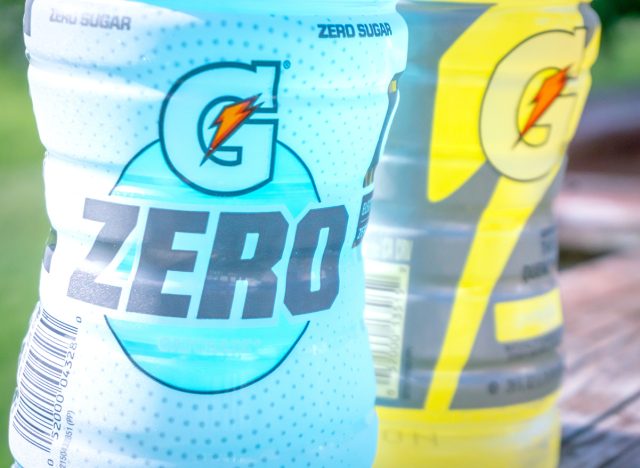

The most drastic change from the OG, Gatorade Zero, which hit stores in 2018, is exactly that what the name implies: zero sugar, zero carbs, and zero chance that a real serious athlete is going to drink this stuff while training. The upside is, it’s a pretty good choice for almost everybody else: regular people out walking in the park, or attending a concert, or doing yard work under the hot sun. If you are sick or hungover or hitting the treadmill for a half hour, it’s a good move, too. You get fluid, you get electrolytes, everything but sugar-slash-carbs. “This isn’t the beverage for an athlete,” Goodson admits. “It was designed to meet the needs of people who need hydration but are maybe not burning so much energy and don’t need a lot of sugar.” If you are avoiding artificial sweeteners, however, this one is a definite “zero” for you: it contains both Sucralose and acesulfame potassium (Ace-K).
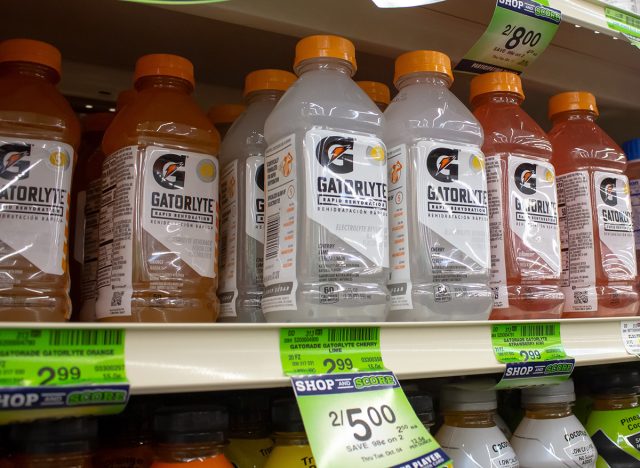

Like the brand’s other modern innovations, Gatorlyte, launched in bottle form in 2021, is a lot lower in sugar than the original: 12 grams in a 20-ounce bottle. What really sets it apart, however, is a significantly higher dose of electrolytes: more than four times as much potassium (350 mg) and nearly double the sodium (490 mg). It also contains extra electrolytes (calcium, chloride and magnesium) that the OG doesn’t have. While it also contains the natural sweetener stevia, the flavor is Dead Sea-salty compared to other varieties, which may be a turn-off. (If you suffer from high-blood pressure, steer clear—it’s a lot of salt!) Designed for “rapid rehydration,” according to the company, this formula is nonetheless very helpful in many situations: athletes suffering from cramps, workers who toil for long hours in the heat, and, yes, even those of you who may have over-indulged in holiday revelry. “If people are a little more dehydrated and it’s causing them to be sick, then I would go with Gatorlyte,” Goodson says.
Source:






